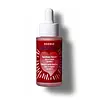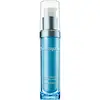What's inside
What's inside
 Key Ingredients
Key Ingredients

 Benefits
Benefits

 Concerns
Concerns

 Ingredients Side-by-side
Ingredients Side-by-side

Water
Skin ConditioningCaprylic/Capric Triglyceride
MaskingAscorbyl Tetraisopalmitate
AntioxidantRosa Canina Fruit Oil
EmollientGlycerin
HumectantSqualane
EmollientEthylhexyl Methoxycinnamate
UV AbsorberTocopheryl Acetate
AntioxidantBisabolol
MaskingButyl Methoxydibenzoylmethane
UV AbsorberCitronellol
PerfumingEthylhexyl Salicylate
UV AbsorberEthylhexylglycerin
Skin ConditioningGeraniol
PerfumingHelianthus Annuus Seed Oil
EmollientHydrolyzed Algae Extract
Skin ConditioningLactic Acid
BufferingLonicera Caprifolium Flower Extract
PerfumingLonicera Japonica Flower Extract
Skin ConditioningMelia Azadirachta Extract
Skin ConditioningMoringa Oleifera Seed Oil
EmollientPancratium Maritimum Extract
BleachingPanthenol
Skin ConditioningPotassium Sorbate
PreservativeRosa Damascena Flower Oil
MaskingRosmarinus Officinalis Extract
AntimicrobialSodium Benzoate
MaskingSodium Chloride
MaskingTocopherol
AntioxidantZingiber Officinale Root Extract
MaskingWater, Caprylic/Capric Triglyceride, Ascorbyl Tetraisopalmitate, Rosa Canina Fruit Oil, Glycerin, Squalane, Ethylhexyl Methoxycinnamate, Tocopheryl Acetate, Bisabolol, Butyl Methoxydibenzoylmethane, Citronellol, Ethylhexyl Salicylate, Ethylhexylglycerin, Geraniol, Helianthus Annuus Seed Oil, Hydrolyzed Algae Extract, Lactic Acid, Lonicera Caprifolium Flower Extract, Lonicera Japonica Flower Extract, Melia Azadirachta Extract, Moringa Oleifera Seed Oil, Pancratium Maritimum Extract, Panthenol, Potassium Sorbate, Rosa Damascena Flower Oil, Rosmarinus Officinalis Extract, Sodium Benzoate, Sodium Chloride, Tocopherol, Zingiber Officinale Root Extract
Water
Skin ConditioningGlycerin
HumectantDimethicone
EmollientButylene Glycol
HumectantNeopentyl Glycol Diheptanoate
EmollientAluminum Starch Octenylsuccinate
AbsorbentIsododecane
EmollientDimethiconol
EmollientAmmonium Acryloyldimethyltaurate/Vp Copolymer
Ethylhexylglycerin
Skin ConditioningBenzyl Alcohol
PerfumingSodium Lactate
BufferingCetearyl Olivate
Bisabolol
MaskingChlorphenesin
AntimicrobialSorbitan Olivate
EmulsifyingSodium PCA
HumectantParfum
MaskingSodium Hyaluronate
HumectantAcrylates/C10-30 Alkyl Acrylate Crosspolymer
Emulsion StabilisingSorbitol
HumectantChondrus Crispus Extract
Skin ConditioningSodium Hydroxide
BufferingProline
Skin ConditioningPortulaca Oleracea Extract
Skin ConditioningPropylene Glycol
HumectantCitric Acid
BufferingMagnesium Aspartate
Skin ConditioningZinc Gluconate
Skin ConditioningCopper Gluconate
Skin ConditioningWater, Glycerin, Dimethicone, Butylene Glycol, Neopentyl Glycol Diheptanoate, Aluminum Starch Octenylsuccinate, Isododecane, Dimethiconol, Ammonium Acryloyldimethyltaurate/Vp Copolymer, Ethylhexylglycerin, Benzyl Alcohol, Sodium Lactate, Cetearyl Olivate, Bisabolol, Chlorphenesin, Sorbitan Olivate, Sodium PCA, Parfum, Sodium Hyaluronate, Acrylates/C10-30 Alkyl Acrylate Crosspolymer, Sorbitol, Chondrus Crispus Extract, Sodium Hydroxide, Proline, Portulaca Oleracea Extract, Propylene Glycol, Citric Acid, Magnesium Aspartate, Zinc Gluconate, Copper Gluconate
Ingredients Explained
These ingredients are found in both products.
Ingredients higher up in an ingredient list are typically present in a larger amount.
Bisabolol is famous for its skin soothing properties. It does this by blocking inflammatory signals, helping to reduce your body's reaction to irritation.
This ingredient also interferes with the process of hyperpigmentation. This can help with reducing dark spots and uneven tone.
Bisabolol is an antioxidant. Antioxidants help fight free-radicals. Free-radicals are molecules that may damage your skin cells. By fighting these free-radicals, Bisabolol may slow down signs of aging.
Studies have shown Bisabolol to have antimicrobial properties and may be a fungicide. These properties help preserve a product's shelf life.
All these properties makes bisabolol a great skin barrier helper ingredient.
Bisabolol also helps the absorption of other ingredients.
Note: Synthetic Bisabolol has been shown to be less effective.
Learn more about BisabololEthylhexylglycerin (we can't pronounce this either) is commonly used as a preservative and skin softener. It is derived from glyceryl.
You might see Ethylhexylglycerin often paired with other preservatives such as phenoxyethanol. Ethylhexylglycerin has been found to increase the effectiveness of these other preservatives.
Glycerin is already naturally found in your skin. It helps moisturize and protect your skin.
A study from 2016 found glycerin to be more effective as a humectant than AHAs and hyaluronic acid.
As a humectant, it helps the skin stay hydrated by pulling moisture to your skin. The low molecular weight of glycerin allows it to pull moisture into the deeper layers of your skin.
Hydrated skin improves your skin barrier; Your skin barrier helps protect against irritants and bacteria.
Glycerin has also been found to have antimicrobial and antiviral properties. Due to these properties, glycerin is often used in wound and burn treatments.
In cosmetics, glycerin is usually derived from plants such as soybean or palm. However, it can also be sourced from animals, such as tallow or animal fat.
This ingredient is organic, colorless, odorless, and non-toxic.
Glycerin is the name for this ingredient in American English. British English uses Glycerol/Glycerine.
Learn more about GlycerinWater. It's the most common cosmetic ingredient of all. You'll usually see it at the top of ingredient lists, meaning that it makes up the largest part of the product.
So why is it so popular? Water most often acts as a solvent - this means that it helps dissolve other ingredients into the formulation.
You'll also recognize water as that liquid we all need to stay alive. If you see this, drink a glass of water. Stay hydrated!
Learn more about Water